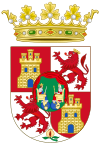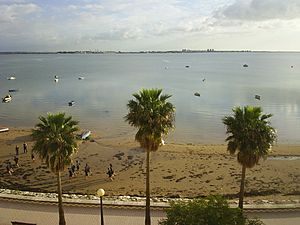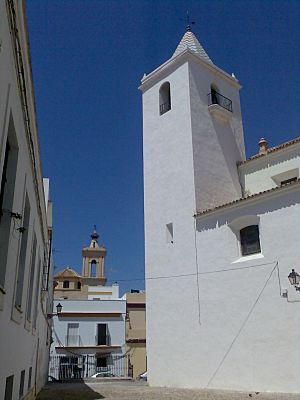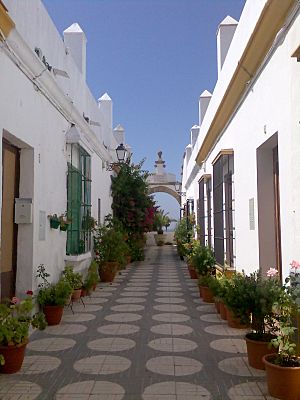Puerto Real facts for kids
Quick facts for kids
Puerto Real
|
|||
|---|---|---|---|
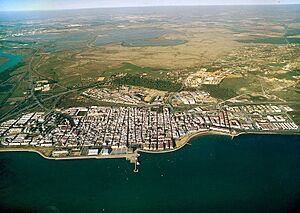 |
|||
|
|||
| Country | Spain | ||
| Autonomous community | Andalusia | ||
| Province | Cádiz | ||
| Founded | 1483 | ||
| Area | |||
| • Total | 195.96 km2 (75.66 sq mi) | ||
| Elevation | 8 m (26 ft) | ||
| Population
(2018)
|
|||
| • Total | 41,650 | ||
| • Density | 212.543/km2 (550.48/sq mi) | ||
| Demonym(s) | Puertorrealeños | ||
| Time zone | UTC+1 (CET) | ||
| • Summer (DST) | UTC+2 (CEST) | ||
| Postal code |
11510
|
||
Puerto Real (Spanish pronunciation: [ˈpweɾto reˈal]) is a town in Spain. It is located in the province of Cádiz, which is part of the Andalusia region. In 2010, about 40,667 people lived there.
The town sits on the northern side of the Bay of Cádiz. It was started in 1483 by the Catholic Monarchs, who were the king and queen of Spain at the time. Puerto Real has nice public squares and wide streets. It also has a town hall and a church from the 1500s. This church was built in different styles, like Gothic, Renaissance, and Baroque.
Contents
Exploring Puerto Real's Geography
The town of Puerto Real has two main areas. One is close to the sea, and the other is more inland. The main part of Puerto Real is in the maritime (sea) zone. It faces the Bay of Cádiz and the Atlantic Ocean. The inland area is much larger but has fewer people.
Puerto Real is surrounded by other towns and cities. To the southwest is San Fernando. To the south is Chiclana de la Frontera. Medina Sidonia is to the southeast. To the north and northeast is Jerez de la Frontera. Finally, El Puerto de Santa Maria is to the northwest.
Natural Beauty and Wildlife
A big part of Puerto Real is within the Bay of Cádiz Natural Reserve. This area is famous for its salt marshes. These marshes are wetlands where salty water collects. Reeds from the marshes are used to make walls for fish farms. These wetlands are also a resting place for many migratory birds. These birds stop here in spring and autumn on their long journeys.
Puerto Real also has beautiful pine forests. Two well-known ones are Las Canteras (Forest of Quarries) and La Algaida (Mare's Meadow Forest). Because of its forests and marshy areas, Puerto Real is sometimes called the "green lung" of the Bay of Cádiz. This means it's like the lungs of the area, helping to keep the air clean.
Rivers and Bridges
The San Pedro river flows along the northwest side of the town. It separates Puerto Real from El Puerto de Santa Maria. Puerto Real is connected to Cádiz by the José León de Carranza Bridge. This bridge is named after a former mayor of Cádiz. Another bridge was planned in 2007 to help with travel.
The area also has many paths, gorges, and ravines. One special path is a long green corridor. It is part of the Two Bays Trail. This trail connects the two large bays of the province of Cádiz: the Bay of Cádiz and the Bay of Algeciras.
There are also two other areas where people live within Puerto Real's borders. These are the District of Jarana and the District of the San Pedro river. They are not directly connected to the main part of the town.
History of Puerto Real
People have lived in the area of Puerto Real for a very long time. There are signs of settlements from prehistoric times and the Roman era. Some historians think Puerto Real might be where the Roman town of Portus Gaditanus was located. This was a port for the Roman city of Gades (which is now Cádiz).
Founding of the Town
The Catholic Monarchs officially founded Puerto Real in 1483. They wanted a royal town (a place controlled by the king and queen) for naval operations. At that time, powerful nobles controlled most other ports in the area. Puerto Real's success was always linked to other ports, especially Cádiz. Cádiz became very rich from trading with America.
The French Invasion (1823)
In 1820, there was a revolt in Spain. People wanted to bring back a liberal constitution from 1812. This led to King Ferdinand VII being held in Cádiz. The liberal parliament met there. Other European countries, who supported kings, decided to help Ferdinand. France sent an army called the Hundred Thousand Children of St. Louis.
On April 7, 1823, the French army surrounded Cádiz from Puerto Real and San Fernando. The Spanish forces held Fort San Luis on the island of Trocadero. This fort was between Cádiz and Puerto Real. When the French took the fort on August 31, 1823, the liberal cause was lost. The defenders of Cádiz gave up. They agreed to release King Ferdinand VII. In return, the king promised to forgive the liberal fighters and set up a constitutional monarchy.
During this siege, the French army badly damaged Puerto Real. They even destroyed its water system. This might be why the town had many sickness outbreaks in the 1800s. Another reminder of the French invasion is the Cortadura canal. The Spanish built this canal to stop the French artillery from getting too close to Cádiz.
Industrial Growth
At the end of the 1800s, Puerto Real saw a big growth in industry. This was thanks to new shipyards built by Antonio López. New technology and industries changed the town's look. An old working-class neighborhood was removed for the shipyards. But new neighborhoods, like the River San Pedro and Marquesado districts, grew up.
Puerto Real's Economy
Puerto Real's economy mostly relies on industry.
Shipbuilding and Repairs
For centuries, shipbuilding was the most important industry here. However, in the last 10-15 years, it has faced problems. This is due to strong competition from shipbuilders in Southeast Asia. Shipyards in Spain and Europe have found it hard to compete. This is because Asian companies can build ships more cheaply and efficiently.
Airplane Parts Manufacturing
While shipbuilding has slowed down, the airplane-building industry is doing well. Airbus has a factory in Puerto Real. This factory builds parts for the huge Airbus A380 airplane, like the tail and rudder. The Puerto Real factory also makes parts for the A320, A330, and A340 airplanes.
Other Industries
Many smaller companies in Puerto Real provide services and labor for the larger industries. The difficulties in the shipbuilding industry have also affected these smaller businesses.
Economic Changes
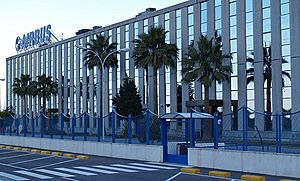
Because shipbuilding has declined, Puerto Real has lost a big part of its industrial base. This has hurt the economy of the whole Bay of Cádiz area. The region is trying to change its economy. It wants to depend less on heavy industry and more on tourism.
However, Puerto Real is an industrial town. It doesn't have many fine beaches like some of its neighbors. So, changing to a tourism-based economy has been slow and difficult. The town still has a high birth rate, and its citizens are getting younger. Young people often have to look for jobs in other parts of Spain or even leave the country.
Since it lacks great beaches, Puerto Real is focusing on "rural tourism." This means promoting activities like golf, horseback riding, walking, hiking, bicycling, and nature trips. The local countryside has become very important. Now, Puerto Real builds hiking paths and golf courses instead of ocean-going ships. Other towns in the Bay of Cádiz area, like San Fernando, El Puerto de Santa Maria, and Cádiz itself, are doing similar things.
Places to Visit in Puerto Real
- Campus of Puerto Real (University of Cádiz): A university campus.
- Parque natural of the Quarries: The only place in Europe where you can find chameleons in the wild.
- Forest of the Quarries: A beautiful forest.
- La Algaida: Another notable forest.
- The harborside walking tour: A nice walk along the port.
- The Trocadero: An old military settlement from the 1700s. It gave its name to a famous square in Paris after a battle.
- The San Pedro river's unique landscape: Surrounded by pine trees.
- Saint Sebastian Church: Built between the 1500s and 1700s, showing Gothic, Renaissance, and Baroque styles.
- Victory's Church: A Baroque church from the 1600s.
- Saint Joseph Church: A Neoclassic church from the 1700s.
- Municipal Market: A market building from the 1700s.
Culture and Community Life
The social life in Puerto Real is built around neighborhood groups, religious groups, and other clubs. The yearly pre-Lenten carnival is a very important event. People prepare for it all year long!
Famous People from Puerto Real
- Juan Antonio Campuzano Hoyos: A writer and military captain.
- Eduardo Alvarez Alfaro: A musician and composer.
- Pedro Alvarez Hidalgo: A composer and musician.
- Francisco Corral Boat: A politician.
- Juan Jose Bottaro and Palmer: A sculptor.
- Canalejas of Puerto Real: A flamenco singer.
- Daily: A carnival performer.
- Francisco Fernández Rodríguez, "Gallego": A soccer player.
- José Gámez Boundary: A priest and writer.
- Juan García, "Mondeño": A bullfighter.
- Ernesto Lopez, "Claudius Frollo": A writer.
- Pedro de Matheu Montalvo: A painter.
- Antonio Muro: A historian, known as the "father" of local history.
- José Belizón Tocino: A painter.
- Diego Vargas, "the Fillo": A flamenco singer.
- José Antonio Chanivet: An artist and painter.
- Pepin De La Fuente: An artist and painter.
See also
 In Spanish: Puerto Real para niños
In Spanish: Puerto Real para niños



